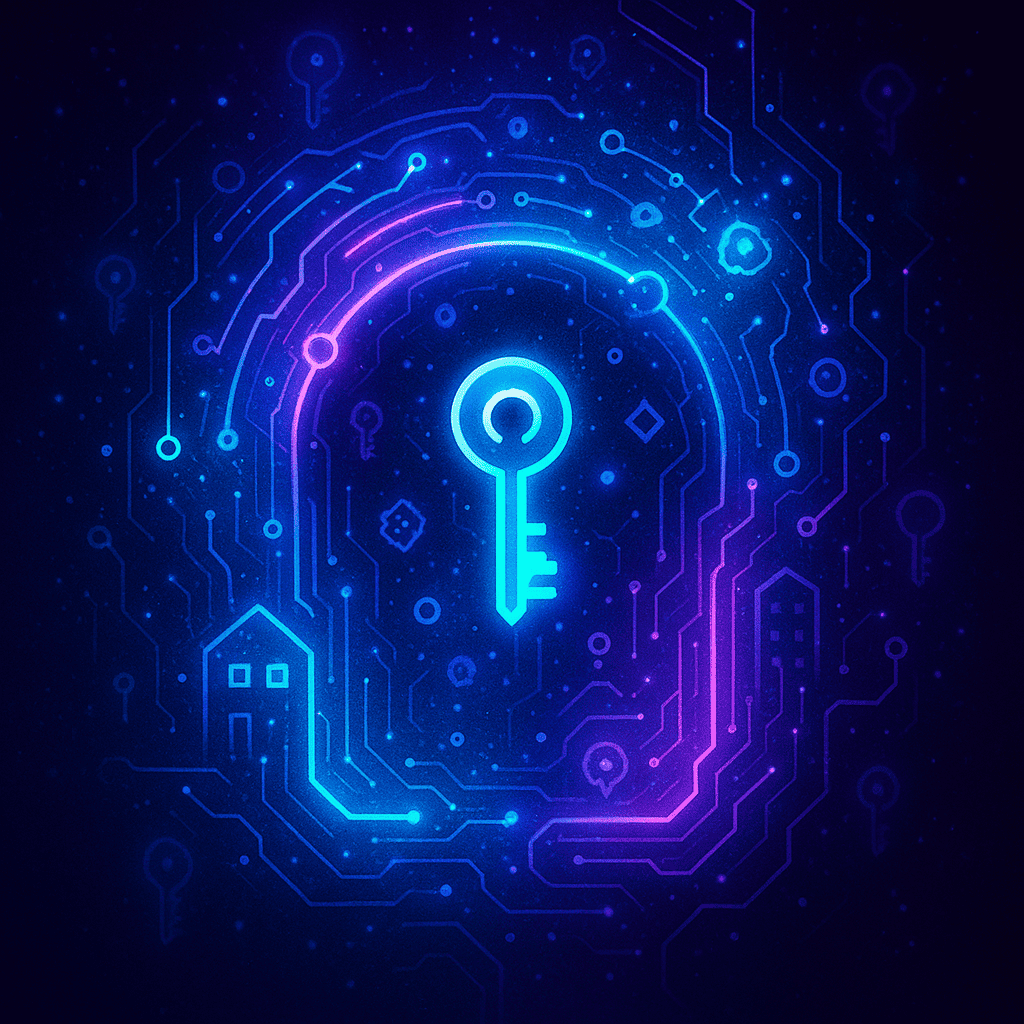The Future of Digital Key Systems: 2026 and Beyond
Alexander Stasiak
Aug 05, 2025・9 min read
Table of Content
🆔 Introduction to Digital Identity
🔮 1. From Access to Intelligence
🌐 2. Cross-Vendor Interoperability
💾 Decentralized Storage Solutions
🤖 3. Embedded AI in Smart Locks
🔐 4. Decentralized Identity and Blockchain Keys
📱 5. Multi-Device Access & Context Awareness
📊 6. Zero Trust Access by Default
🧠 7. Access as a Data Layer
🛠️ 8. No-Code + API First Platforms
⚠️ 9. Privacy-First Architecture
🗂️ Digital Asset Management
🧪 10. AI-Personalized Access Journeys
✅ Conclusion
Want to future-proof your access platform?
We help companies build next-gen digital key solutions.👇
Digital keys have already replaced plastic cards and metal keys. But the real transformation is just beginning.
This marks a significant shift from traditional digital locks to decentralized, intelligent ecosystems that redefine how we manage access.
By 2026 and beyond, access control will evolve from “digital locks” to intelligent, decentralized, and predictive ecosystems — fully embedded in our physical and digital environments.
Innovation will be a driving force behind the evolution of digital key systems, enabling new capabilities and smarter solutions.
Let’s explore the key shifts shaping the future.
A main problem that must be addressed is ensuring the authenticity and security of digital identity and access control in these advanced systems.
🆔 Introduction to Digital Identity
In today’s hyper-connected world, your identity is no longer defined solely by a passport or a driver’s license tucked away in a wallet. Instead, your digital identity—comprised of unique credentials, traits, and online records—serves as your passport to the digital universe. As we move toward 2026 and beyond, the concept of decentralized identity is transforming how individuals create, control, and secure their personal data.
Leveraging blockchain technology, particularly the Bitcoin blockchain, decentralized identity solutions empower users to manage their digital presence in a truly decentralized manner. Platforms like .LOCKER enable anyone to create a secure digital locker, where personal documents and identity credentials are stored and managed without relying on a central authority. This approach not only enhances security but also gives users full control over their identity, allowing them to decide how, when, and with whom their information is shared. In a world where data privacy and security are paramount, decentralized digital identity is setting a new standard for trust and transparency.
🔮 1. From Access to Intelligence
Tomorrow’s digital key systems won’t just let people in. They’ll understand context, analyze behavior, and make decisions in real time.
Expect:
- AI-based risk scoring
- Behavioral anomaly detection
- Dynamic access permissions
- Predictive routing of users to lockers or rooms
- Real-time intent estimation (“Is this person expected here?”)
These intelligent systems will leverage a decentralized network to process data and make real-time access decisions.
🌐 2. Cross-Vendor Interoperability
Right now, most systems are siloed: Roger doesn’t talk to Brand X; App A can’t control Lock B.
The future: Open protocols and access marketplaces, where keys can be shared across brands and environments.
Example: A guest receives a single QR key that works for:
- The coworking building entrance
- A smart locker
- A bike-sharing hub
- An event check-in kiosk
With open protocols, users can connect their digital wallets and identities across multiple access points and brands, enabling seamless participation and control in decentralized environments.
Think “Apple Pay”, but for physical access.
💾 Decentralized Storage Solutions
The rise of decentralized storage solutions, such as the Inter Planetary File System (IPFS), is revolutionizing how we store and protect our most valuable digital assets. Unlike traditional systems that rely on centralized servers, decentralized networks distribute data across multiple nodes, ensuring that personal documents and sensitive information are stored in a secure and resilient manner.
With decentralized storage, users gain robust access control over their data, deciding exactly who can view or use their documents and when. This is especially critical for identity verification documents, which demand the highest levels of security and privacy. For example, you can store your passport or driver’s license in a decentralized locker and grant access to a service provider or employer with just a few clicks—knowing your information is protected against data breaches and information leaks. By leveraging decentralized technology, users can safeguard their digital assets and personal documents, maintaining privacy and control in an increasingly interconnected world.
🤖 3. Embedded AI in Smart Locks
Smart locks will include:
- Tiny AI chips for edge-level decisions
- Offline facial recognition
- Motion and tamper detection
- Environmental sensors (temperature, presence, sound)
They'll work with — not just react to — their surroundings.
🔐 4. Decentralized Identity and Blockchain Keys
Web3 will reach smart access.
- Self-sovereign identity (SSI) models
- NFT‑style access keys (non-fungible, traceable)
- Smart contracts controlling access based on rules (e.g. payment received, score met)
Users can verify their identity and access rights using blockchain-based systems, ensuring secure and legitimate entry to digital and physical spaces.
Example: You gain access to a gated coworking hub only while your subscription NFT is active.
In Web3, a domain acts as a digital identity marker, representing your unique presence and ownership across decentralized platforms.
A locker domain, such as .LOCKER, can be used to enhance decentralized identity and access management by providing a secure, blockchain-based identifier.
Registering and managing domain names enables secure, decentralized access control, allowing users to link their digital identity to wallets and verify ownership within the Web3 ecosystem.
📱 5. Multi-Device Access & Context Awareness
No more: “Your phone is your key.” Future systems will allow access via:
- Smart glasses
- Wearables (rings, badges, watches)
- Voice + biometric fusion
- Car integrations (open the garage via Tesla app)
- Temporary facial scan access with auto-deletion
Your context defines your access, not just your device.
Users can also manage their access permissions and digital lockers through a secure website interface.
📊 6. Zero Trust Access by Default
In sensitive sectors (e.g. fintech, pharma, government), access will become conditional by default.
- Dynamic PINs based on time/location
- One-time unlock links
- Real-time scoring from user behavior
- Temporary policy-based access for auditors, robots, or cleaners
🧠 7. Access as a Data Layer
Access logs will no longer be “just logs”. They’ll feed real-time analytics dashboards:
- Occupancy optimization
- Predictive maintenance (e.g. locker door hinges)
- Safety alerts
- Energy-saving policies (e.g. heating only if door opened)
With blockchain-based document management systems, every access event can be recorded as part of a verifiable audit trail, ensuring transparency and accountability through secure, immutable records.
Access becomes a source of operational intelligence.
🛠️ 8. No-Code + API First Platforms
Digital access will become productized — available to anyone:
- Drag & drop access workflows
- Prebuilt mobile app modules
- Low-code integrations with CRMs, payments, HR, PMS
- White-labeling in minutes
Proptech companies and facility operators will create new services in hours, not months.
Developers can also use these platforms to develop custom access solutions and integrations tailored to their specific needs.
⚠️ 9. Privacy-First Architecture
Privacy will become a differentiator.
Expect:
- Local-only storage of biometric data
- Anonymous access analytics
- Clear user consent models
- Ability to audit “who saw what data”
- Compliance with AI Act and ISO/IEC 42001 (AI management systems)
All biometric and access data are encrypted to ensure privacy and protect against unauthorized access. The system enables users to store and share documents securely, safeguarding sensitive information through encryption and decentralized storage. This privacy-first architecture helps prevent information breaches by minimizing data exposure and reducing the risk of hacking or insider theft. By avoiding centralized server storage and leveraging blockchain-based solutions, users benefit from enhanced security, user control, and tamper-proof records.
🗂️ Digital Asset Management
Managing digital assets has become a cornerstone of the decentralized identity revolution. Thanks to blockchain technology, users can now create, store, and transfer digital assets—such as cryptocurrencies and tokens—in a secure, decentralized manner. Digital wallets and decentralized applications (DApps) provide intuitive tools for users to interact with blockchain-based services, all while keeping their assets and identity under their own control.
Encryption keys and decentralized apps ensure that only the rightful owner can access and transfer their digital assets, eliminating the need for a central authority. For instance, you can use a digital wallet to store your cryptocurrencies and, with a decentralized application, transfer them to another user securely and transparently. This serverless fashion of managing digital assets not only enhances security but also streamlines the process, making it efficient and user-friendly. As decentralized identity and asset management continue to evolve, users are empowered to take full ownership of their digital lives—protecting their privacy, ensuring data integrity, and enabling seamless transactions across the digital landscape.
🧪 10. AI-Personalized Access Journeys
Imagine:
- Your key opens the exact locker where your parcel was dropped
- Your elevator takes you directly to the right floor
- Your app guides you via AR to your next desk or meeting room
Each access event becomes personal, predictive, and invisible.
Personalized access journeys can also include securely sharing temporary access with other users, ensuring convenience and control.
✅ Conclusion
Access control is evolving from “who can open this door” to “how can we shape better, safer, and more intelligent environments.”
Decentralized digital lockers are transforming the internet by changing how websites and digital identities are managed, bridging traditional and Web3 solutions. For personal use, these lockers allow individuals to manage credentials and access securely, keeping private information protected. Digital identities and access systems are created and secured using blockchain technology, ensuring trust and resilience. The industry is continually creating innovative solutions to enhance secure digital access and identity management.
Digital key platforms of the future will be:
- AI-driven
- Open and interoperable
- Privacy-aware
- Fully embedded into user journeys
The only question is: Will you build for that future — or be locked out of it?
Digital Transformation Strategy for Siemens Finance
Cloud-based platform for Siemens Financial Services in Poland


You may also like...

Top 7 Integrated Digital Key Solutions for Smart Homes and Businesses [Comparison 2025]
We compare the top 7 digital key solutions for 2025, helping you choose the right system for your home or business.
Alexander Stasiak
Aug 11, 2025・8 min read

AI-Powered Product Discovery for Enterprises: 2025 Implementation Guide
Traditional product discovery is slow, biased, and expensive. In 2025, AI-powered product discovery helps enterprises analyze millions of data points, predict successful product opportunities, and shorten innovation cycles from months to days. Here’s how to implement it step by step.

Alexander Stasiak
Oct 17, 2025・15 min read

Exploring Alternatives to Nearshore Software Development Outsourcing: A Practical Guide
Choosing the right strategy for software development is essential. While nearshore outsourcing has its benefits, exploring alternatives such as offshore teams, in-house development, and freelance developers can provide businesses with tailored solutions. This guide offers practical insights into these options, helping organizations make informed decisions that align with their unique needs and strategic goals.
Marek Majdak
Jan 30, 2024・13 min read
Let’s build your next digital product — faster, safer, smarter.
Book a free consultationWork with a team trusted by top-tier companies.








